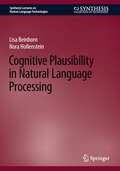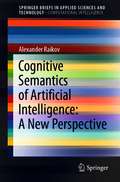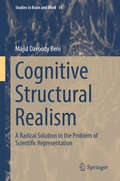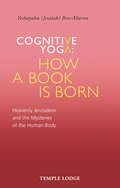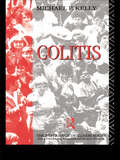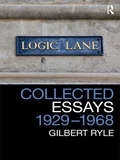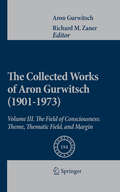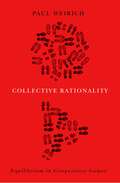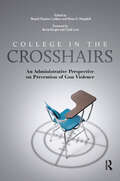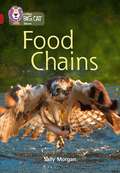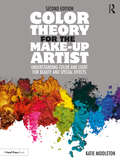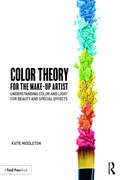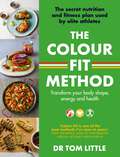- Table View
- List View
Cognitive Penetrability and the Epistemic Role of Perception (Palgrave Innovations in Philosophy)
by Athanassios RaftopoulosThis book is about the interweaving between cognitive penetrability and the epistemic role of the two stages of perception, namely early and late vision, in justifying perceptual beliefs. It examines the impact of the epistemic role of perception in defining cognitive penetrability and the relation between the epistemic role of perceptual stages and the kinds (direct or indirect) of cognitive effects on perceptual processing. The book presents the argument that early vision is cognitively impenetrable because neither is it affected directly by cognition, nor does cognition affect its epistemic role. It also argues that late vision, even though it is cognitively penetrated and, thus, affected by concepts, is still a perceptual state that does not involve any discursive inferences and does not belong to the space of reasons. Finally, an account is given as to how cognitive states with symbolic content could affect perceptual states with iconic, analog content, during late vision.
Cognitive Plausibility in Natural Language Processing (Synthesis Lectures on Human Language Technologies)
by Lisa Beinborn Nora HollensteinThis book explores the cognitive plausibility of computational language models and why it’s an important factor in their development and evaluation. The authors present the idea that more can be learned about cognitive plausibility of computational language models by linking signals of cognitive processing load in humans to interpretability methods that allow for exploration of the hidden mechanisms of neural models. The book identifies limitations when applying the existing methodology for representational analyses to contextualized settings and critiques the current emphasis on form over more grounded approaches to modeling language. The authors discuss how novel techniques for transfer and curriculum learning could lead to cognitively more plausible generalization capabilities in models. The book also highlights the importance of instance-level evaluation and includes thorough discussion of the ethical considerations that may arise throughout the various stages of cognitive plausibility research.
Cognitive Semantics of Artificial Intelligence: A New Perspective (SpringerBriefs in Applied Sciences and Technology)
by Alexander RaikovThis book addresses the issue of cognitive semantics’ aspects that cannot be represented by traditional digital and logical means. The problem of creating cognitive semantics can be resolved in an indirect way. The electromagnetic waves, quantum fields, beam of light, chaos control, relativistic theory, cosmic string recognition, category theory, group theory, and so on can be used for this aim. Since the term artificial intelligence (AI) appeared, various versions of logic have been created; many heuristics for neural networks deep learning have been made; new nature-like algorithms have been suggested. At the same time, the initial digital, logical, and neural network principles of representation of knowledge in AI systems have not changed a lot. The researches of these aspects of cognitive semantics of AI are based on the author's convergent methodology, which provides the necessary conditions for purposeful and sustainable convergence of decision-making.
Cognitive Structural Realism: A Radical Solution to the Problem of Scientific Representation (Studies in Brain and Mind #14)
by Majid Davoody BeniIn this book, the author develops a new form of structural realism and deals with the problem of representation. The work combines two distinguished developments of the Semantic View of Theories, namely Structural Realism (SR), a flourishing theory from contemporary philosophy of science, and Ronald Giere and colleagues’ Cognitive Models of Science approach (CMSA).Readers will see how replacing the model-theoretic structures that are at issue in SR with connectionist networks and activations patterns (which are the formal tools of computational neuroscience) helps us to deal with the problem of representation. The author suggests that cognitive structures are not only the precise formal tools for regimenting the structure of scientific theories but also the tools that the biological brain uses to capture the essential features (i.e., structures) of its environment. Therefore, replacing model-theoretic structures with cognitive structures allows us to account for the theories-reality relationship on the basis of the most reliable theories of neurology. This is how a new form of SR, called Cognitive Structural Realism (CSR) is introduced through this book, which articulates and defends CSR, and shows how two diverging branches of SVT can be reconciled.This ground-breaking work will particularly appeal to people who work in the philosophy of science, philosophy of mind and cognitive sciences.
Cognitive Systems and the Extended Mind (Philosophy of Mind)
by Robert D. RupertCognitive Systems and the Extended Mind surveys philosophical issues raised by the situated movement in cognitive science, that is, the treatment of cognitive phenomena as the joint products of brain, body, and environment.
Cognitive Systems and the Extended Mind (Philosophy of Mind)
by Robert D. RupertCognitive Systems and the Extended Mind surveys philosophical issues raised by the situated movement in cognitive science, that is, the treatment of cognitive phenomena as the joint products of brain, body, and environment.
Cognitive Yoga: Heavenly Jerusalem and the Mysteries of the Human Body
by Yeshayahu Ben-Aharon‘This little book relates some experiences I had during the spiritual research which was eventually published in my book Cognitive Yoga. Usually I am concerned with communicating the objective results of my research and not what I experienced whilst doing it. But an objective description of what the individual soul undergoes during spiritual research can be valuable to the study of anthroposophy and to those who pursue the spiritual path themselves.’Through faithful inner work, says the author, the path of spiritual science can become a living spiritual being – an intimate friend in the realms of soul and spirit. This being can blossom into an extended spiritual community or school. One can converse and co-create with this spiritual school, including the being of one’s teacher, by learning its inner language. In 2012, Yeshayahu Ben-Aharon was confronted with a major obstacle in his research work. After struggling alone, he felt he could not progress without consulting his colleagues in the spiritual world. The intimate soul experiences described in this book took place during such a gathering – a special, festive occasion with an active and engaged community of spiritual beings.‘I want to share some aspects of what I experienced during this event, in the more personal and imaginative language of storytelling. It is a kind of new, individual, Christmas nativity tale, about the earthly ripening of a research problem, its heavenly conception, embryonic life, and finally the birth on earth of what becomes a physical book, printed black on white.’
Coleen’s Real Style
by Coleen RooneyWhat Coleen Rooney doesn't know about style and shopping isn't worth knowing, and she is a fashion inspiration to girls everywhere. Now she's put together a glossy, gorgeous style guide that contains everything you could EVER want to know about high-street fashion, beauty, hair and makeup, body care and style.
Colitis
by Michael P. KellyUlcerative colitis is a chronic condition that has a number of long-term complications and creates certain short-term problems for the sufferer. Michael Kelly, himself a sufferer, describes the experience of ulcerative colitis from the perspective of men and women who have had the disease and examines the social and psychological issues surrounding the condition.
Colitis
by Michael P. KellyUlcerative colitis is a chronic condition that has a number of long-term complications and creates certain short-term problems for the sufferer. Michael Kelly, himself a sufferer, describes the experience of ulcerative colitis from the perspective of men and women who have had the disease and examines the social and psychological issues surrounding the condition.
Collaboration Technologies and Social Computing: 28th International Conference, CollabTech 2022, Santiago, Chile, November 8–11, 2022, Proceedings (Lecture Notes in Computer Science #13632)
by Lung-Hsiang Wong Yugo Hayashi Cesar A. Collazos Claudio Alvarez Gustavo Zurita Nelson BaloianThis volume constitutes the proceedings of the 28th International Conference on Collaboration Technologies and Social Computing, CollabTech 2022, held in Santiago, Chile during November 8–11, 2022. The 18 full and 4 work-in-process papers presented in this volume were selected from 37 submissions and underwent careful double-blind peer review. The papers focus on innovative technical, human and organizational approaches to expand collaboration support including computer science, management science, design science, cognitive and social science.
The Collagen Diet: A 28-Day Plan for Sustained Weight Loss, Glowing Skin, Great Gut Health and a Younger You
by Dr Josh Axe"An essential read. The Collagen Diet tells us why collagen is important, why it is so lacking diet in our modern diet, and, most important, what we can do to bring collagen back in the fold in terms of being an amazing protein that we should all be getting more of."-David Perlmutter, MD, author of Grain Brain and the forthcoming Brain Wash"Collagen shows up in nearly every part of the body, from your hair and skin to your arterial walls, gastrointestinal tract, and even your eyes. Dr. Axe presents the science behind this miraculous substance, and explains how you can use it to fight chronic pain, digestive issues, skin issues, and so much more."--Dr. Alejandro Junger, author of Clean***Dr Josh Axe, international bestselling author of Keto Diet and Eat Dirt, explains how to lose weight, prevent disease, improve your digestion, and renew your youth with the miracle of dietary collagen. Collagen is the essential missing link to modern health, with benefits ranging from better weight control, to enhanced digestion, clearer skin, reduced inflammation, and improved immune function. Ancient diets were rich in collagen, from bone broths to nose-to-tail eating, and they were supplemented by fruits and vegetables that provided collagen-boosting vitamin C. Modern diets are missing this much-needed ingredient, resulting in more injuries, chronic aches and pains, digestive issues, and other symptoms associated with aging. Featuring a twenty-eight day meal plan, over seventy mouthwatering recipes and specific advice for supporting your body's collagen production with exercise and lifestyle interventions, The Collagen Diet will help all of us live longer, more vital lives.
Collected Essays 1929 - 1968: Collected Papers Volume 2
by Gilbert RyleGilbert Ryle was one of the most important and yet misunderstood philosophers of the Twentieth Century. Long unavailable, Collected Essays 1929-1968: Collected Papers Volume 2 stands as testament to the astonishing breadth of Ryle’s philosophical concerns. This volume showcases Ryle’s deep interest in the notion of thinking and contains many of his major pieces, including his classic essays ‘Knowing How and Knowing That’, ‘Philosophical Arguments’, ‘Systematically Misleading Expressions’, and ‘A Puzzling Element in the Notion of Thinking’. He ranges over an astonishing number of topics, including feelings, pleasure, sensation, forgetting and concepts and in so doing hones his own philosophical stance, steering a careful path between behaviourism and Cartesianism. Together with the Collected Papers Volume 1 and the new edition of The Concept of Mind, these outstanding essays represent the very best of Ryle’s work. Each volume contains a substantial preface by Julia Tanney, and both are essential reading for any student of twentieth-century philosophies of mind and language. Gilbert Ryle (1900 -1976) was Waynflete Professor of Metaphysics and Fellow of Magdalen College Oxford, an editor of Mind, and a president of the Aristotelian Society. Julia Tanney is Senior Lectuer at the University of Kent, and has held visiting positions at the University of Picardie and Paris-Sorbonne.
Collected Essays 1929 - 1968: Collected Papers Volume 2
by Gilbert RyleGilbert Ryle was one of the most important and yet misunderstood philosophers of the Twentieth Century. Long unavailable, Collected Essays 1929-1968: Collected Papers Volume 2 stands as testament to the astonishing breadth of Ryle’s philosophical concerns. This volume showcases Ryle’s deep interest in the notion of thinking and contains many of his major pieces, including his classic essays ‘Knowing How and Knowing That’, ‘Philosophical Arguments’, ‘Systematically Misleading Expressions’, and ‘A Puzzling Element in the Notion of Thinking’. He ranges over an astonishing number of topics, including feelings, pleasure, sensation, forgetting and concepts and in so doing hones his own philosophical stance, steering a careful path between behaviourism and Cartesianism. Together with the Collected Papers Volume 1 and the new edition of The Concept of Mind, these outstanding essays represent the very best of Ryle’s work. Each volume contains a substantial preface by Julia Tanney, and both are essential reading for any student of twentieth-century philosophies of mind and language. Gilbert Ryle (1900 -1976) was Waynflete Professor of Metaphysics and Fellow of Magdalen College Oxford, an editor of Mind, and a president of the Aristotelian Society. Julia Tanney is Senior Lectuer at the University of Kent, and has held visiting positions at the University of Picardie and Paris-Sorbonne.
Collected Papers, Volume 1: Mind and Language, 1972-2010
by Stephen StichThis volume collects the best and most influential essays that Stephen Stich has published in the last 40 years on topics in the philosophy of mind and the philosophy of language. They discuss a wide range of topics including grammar, innateness, reference, folk psychology, eliminativism, connectionism, evolutionary psychology, simulation theory, social construction, and psychopathology. However, they are unified by two central concerns. The first is the viability of the commonsense conception of the mind in the face of challenges posed by both philosophical arguments and empirical findings. The second is the philosophical implications of research in the cognitive sciences which, in the last half century, has transformed both our understanding of the mind and the ways in which the mind is studied. The volume includes a new introductory essay that elaborates on these themes and offers an overview of the papers that follow.
The Collected Works of Aron Gurwitsch: Volume III: The Field of Consciousness: Theme, Thematic Field, and Margin (Phaenomenologica #194)
by Aron GurwitschThis volume contains Gurwitsch's magnum opus, which emphasizes how items in the thematic field are relevant to the theme. It is introduced by his student Richard Zaner. This volume also includes the posthumous text, Marginal Consciousness.
Collective Agency and Cooperation in Natural and Artificial Systems: Explanation, Implementation and Simulation (Philosophical Studies Series #122)
by Catrin MisselhornThis book brings together philosophical approaches to cooperation and collective agency with research into human-machine interaction and cooperation from engineering, robotics, computer science and AI. Bringing these so far largely unrelated fields of study together leads to a better understanding of collective agency in natural and artificial systems and will help to improve the design and performance of hybrid systems involving human and artificial agents. Modeling collective agency with the help of computer simulations promises also philosophical insights into the emergence of collective agency.The volume consists of four sections. The first section is dedicated to the concept of agency. The second section of the book turns to human-machine cooperation. The focus of the third section is the transition from cooperation to collective agency. The last section concerns the explanatory value of social simulations of collective agency in the broader framework of cultural evolution.
Collective Rationality: Equilibrium in Cooperative Games
by Paul WeirichGroups of people perform acts that are subject to standards of rationality. A committee may sensibly award fellowships, or may irrationally award them in violation of its own policies. A theory of collective rationality defines collective acts that are evaluable for rationality and formulates principles for their evaluation. This book argues that a group's act is evaluable for rationality if it is the products of acts its members fully control. It also argues that such an act is collectively rational if the acts of the group's members are rational. Efficiency is a goal of collective rationality, but not a requirement, except in cases where conditions are ideal for joint action and agents have rationally prepared for joint action. The people engaged in a game of strategy form a group, and the combination of their acts yields a collective act. If their collective act is rational, it constitutes a solution to their game. A theory of collective rationality yields principles concerning solutions to games. One principle requires that a solution constitute an equilibrium among the incentives of the agents in the game. In a cooperative game some agents are coalitions of individuals, and it may be impossible for all agents to pursue all incentives. Because rationality is attainable, the appropriate equilibrium standard for cooperative games requires that agents pursue only incentives that provide sufficient reasons to act. The book's theory of collective rationality supports an attainable equilibrium-standard for solutions to cooperative games and shows that its realization follows from individuals' rational acts. By extending the theory of rationality to groups, this book reveals the characteristics that make an act evaluable for rationality and the way rationality's evaluation of an act responds to the type of control its agent exercises over the act. The book's theory of collective rationality contributes to philosophical projects such as contractarian ethics and to practical projects such as the design of social institutions.
College in the Crosshairs: An Administrative Perspective on Prevention of Gun Violence
by Brandi Hephner LaBanc Brian O. HemphillGun violence – whether rampage shootings, homicides or suicides – is a potential reality all campuses have to face. This book provides leaders in higher education – and particularly those in student affairs – with data about past incidents, an analysis of trends, and background on the national debate about gun policies and how they impact colleges, state by state. It importantly raises issues about student psychological development, mental health, and the prevalence of alcohol and substance abuse on campus, to better inform discussion about allowing guns on campus and concealed carry. It concludes by sharing strategies for averting gun-related tragedies, and offering models for responding when they occur, based on lessons learned and best practices. The book addresses concealed carry legislation and its impact on campus policies by state, examining the concerns of administrators as they discharge their duty of care to students and comply with legal and regulatory frameworks. Asking “Are our students developmentally ready to make a morally sophisticated, life-changing decision to use firearms in response to a real or perceived threat?”, it offers important perspectives and scientific data, so far absent from the debate, to shape the ongoing conversation with lawmakers and the public about what it takes to keep college communities safe.In addressing risk and prevention, contributors cover the relationship between violence and mental health, and the need to establish comprehensive strategic plans and a preventative framework that promotes help-seeking for those in need before they reach the point of crisis, as well as a campus-wide risk assessment team, stressing the importance of cultivating a community-wide approach to campus safety by empowering members to report suspicious behavior. They also offer guidance on improving effective behavior intervention and case management processes.The book concludes by outlining best practices, and providing guidance on developing an emergency plan, practicing and testing systems, and creating a robust communications strategy. Individual chapters focus on how small colleges with limited resources can develop effective plans into by partnering with local agencies; as well as on the steps that community colleges – who generally lack resident advisors and residential staff, and whose students are far more dispersed – can take to diminish risk and respond promptly and professionally to a crisis.This is an essential guide for all higher education leaders concerned about preventing violence on our campuses, and a call to action.
College in the Crosshairs: An Administrative Perspective on Prevention of Gun Violence
Gun violence – whether rampage shootings, homicides or suicides – is a potential reality all campuses have to face. This book provides leaders in higher education – and particularly those in student affairs – with data about past incidents, an analysis of trends, and background on the national debate about gun policies and how they impact colleges, state by state. It importantly raises issues about student psychological development, mental health, and the prevalence of alcohol and substance abuse on campus, to better inform discussion about allowing guns on campus and concealed carry. It concludes by sharing strategies for averting gun-related tragedies, and offering models for responding when they occur, based on lessons learned and best practices. The book addresses concealed carry legislation and its impact on campus policies by state, examining the concerns of administrators as they discharge their duty of care to students and comply with legal and regulatory frameworks. Asking “Are our students developmentally ready to make a morally sophisticated, life-changing decision to use firearms in response to a real or perceived threat?”, it offers important perspectives and scientific data, so far absent from the debate, to shape the ongoing conversation with lawmakers and the public about what it takes to keep college communities safe.In addressing risk and prevention, contributors cover the relationship between violence and mental health, and the need to establish comprehensive strategic plans and a preventative framework that promotes help-seeking for those in need before they reach the point of crisis, as well as a campus-wide risk assessment team, stressing the importance of cultivating a community-wide approach to campus safety by empowering members to report suspicious behavior. They also offer guidance on improving effective behavior intervention and case management processes.The book concludes by outlining best practices, and providing guidance on developing an emergency plan, practicing and testing systems, and creating a robust communications strategy. Individual chapters focus on how small colleges with limited resources can develop effective plans into by partnering with local agencies; as well as on the steps that community colleges – who generally lack resident advisors and residential staff, and whose students are far more dispersed – can take to diminish risk and respond promptly and professionally to a crisis.This is an essential guide for all higher education leaders concerned about preventing violence on our campuses, and a call to action.
Collins Big Cat, Band 14/Ruby: Food Chains (PDF)
by Sally MorganAll living things need food to survive. Find out who eats whom, and how we all link together to form a food chain. • Ruby/Band 14 books give increasing opportunities for children to develop their skills of inference and deduction. • Text type: an information book • Curriculum links: science, geography
Color Theory for the Make-up Artist: Understanding Color and Light for Beauty and Special Effects
by Katie MiddletonColor Theory for the Make-up Artist: Understanding Color and Light for Beauty and Special Effects (Second Edition) analyzes and explains traditional color theory for fine artists and applies it to make-up artistry. This beautifully illustrated guide begins with the basics of color theory – why we see color, how to categorize and identify color, and relationships between colors – and relates these concepts to beauty and special effects make-up. The book provides a wealth of information, including how to mix flesh tones by using only primary colors, how these colors in paints and make-up are sourced and created, the reason for variations in skin colors and undertones, and how to identify and match these using make-up while choosing flattering colors for the eyes, lips, and cheeks. Colors found inside the body are explained for special effects make-up, like why we bruise, bleed, or appear sick. Ideas and techniques are also described for painting prosthetics, in addition to using color as inspiration in make-up designs. The book also discusses how lighting affects color on film, television, theater, and photography sets, and how to properly light a workspace for successful applications. The second edition features: A brand-new chapter on color inspiration in make-up and design Additional and updated diagrams More real-life application photos and demonstrations, including new examples of tattoo covering and prosthetic painting using optical mixtures, airbrush, and stippling Expanded discussion on undertones, skin variations, color correction, pigments, colored gels, and more Filled with stunning photography and practical information, Color Theory for the Make-up Artist provides guidance and inspiration for both professionals and beginners who wish to train their eye further to understand and recognize distinctions in color.
Color Theory for the Makeup Artist: Understanding Color and Light for Beauty and Special Effects
by Katie MiddletonColor Theory for the Make-up Artist: Understanding Color and Light for Beauty and Special Effects analyzes and explains traditional color theory for fine artists and applies it to the make-up artist. This book is suitable for both professionals and beginners who wish to train their eye further to understand and recognize distinctions in color. It explains why we see color, how to categorize and identify color, relationships between colors, and it relates these concepts to beauty and special effects make-up. The book teaches the reader how to mix flesh tones by using only primary colors, and explains how these colors in paints and make-up are sourced and created. It also discusses the reason for variations in skin colors and undertones, and how to identify and match these using make-up, while choosing flattering colors for the eyes, lips, and cheeks. Colors found inside the body are explained for special effects make-up, like why we bruise, bleed, or appear sick. Ideas and techniques are also described for painting prosthetics, in addition to using color as inspiration in make-up designs. The book also discusses how lighting affects color on film, television, theater, and photography sets, and how to properly light a workspace for successful applications.
Color Theory for the Makeup Artist: Understanding Color and Light for Beauty and Special Effects
by Katie MiddletonColor Theory for the Make-up Artist: Understanding Color and Light for Beauty and Special Effects analyzes and explains traditional color theory for fine artists and applies it to the make-up artist. This book is suitable for both professionals and beginners who wish to train their eye further to understand and recognize distinctions in color. It explains why we see color, how to categorize and identify color, relationships between colors, and it relates these concepts to beauty and special effects make-up. The book teaches the reader how to mix flesh tones by using only primary colors, and explains how these colors in paints and make-up are sourced and created. It also discusses the reason for variations in skin colors and undertones, and how to identify and match these using make-up, while choosing flattering colors for the eyes, lips, and cheeks. Colors found inside the body are explained for special effects make-up, like why we bruise, bleed, or appear sick. Ideas and techniques are also described for painting prosthetics, in addition to using color as inspiration in make-up designs. The book also discusses how lighting affects color on film, television, theater, and photography sets, and how to properly light a workspace for successful applications.
The Colour-Fit Method: The secret nutrition and fitness plan used by elite athletes that will transform your body shape, energy and health
by Dr Tom Little'Colour-Fit is an amazing resource that helped me realise one of sports greatest achievements'Wes Morgan, Captain of Leicester City Premier League winning teamThe Colour-Fit Method has only been available to those in professional sport - a secret weapon for athletes to optimise body shape, health and performance. Now, Colour-Fit's founder Dr Tom Little lets you in on the secret, too.The Colour-Fit Method is a revolutionary approach to nutrition and fitness. With over 90 recipes and meal plans, and multiple tailored training and nutrition plans to suit a range of goals, the simple, sustainable and evidence-based method outlined in The Colour-Fit Method will help you to look and feel better, perform at your best and lead a healthier and more active life.Dr Tom Little is a performance and health specialist with over twenty years' professional experience. His Colour-Fit method has rapidly become a revolutionising force in elite sport, having been used by many of the world's best-loved teams, including Manchester City, Arsenal, Chelsea, St Helens, Welsh Rugby Union, Saracens, Melbourne Demons, Sri Lankan Cricket and Manchester United, in addition to multiple motor sport, triathlon and combat athlete champions.'Colour-Fit is one of the best methods I've seen in years'Tony Strudwick, Head of Performance, Arsenal Academy and Welsh FA

